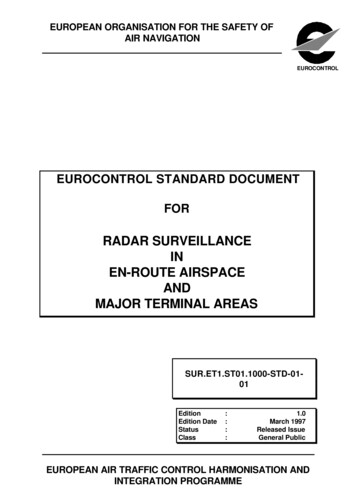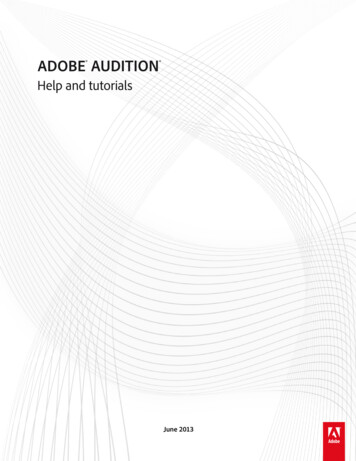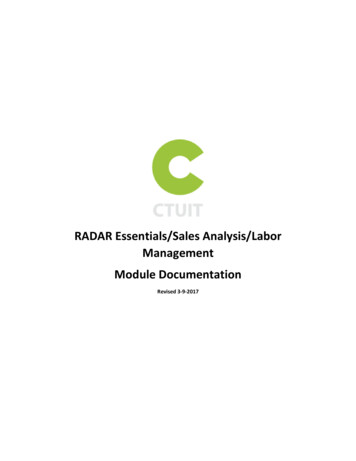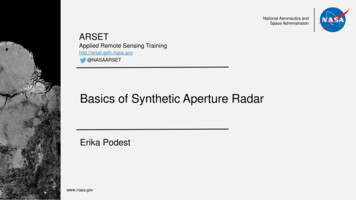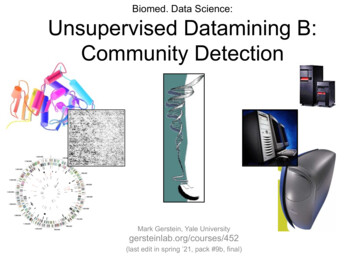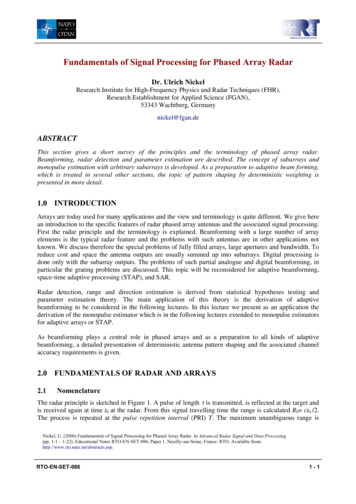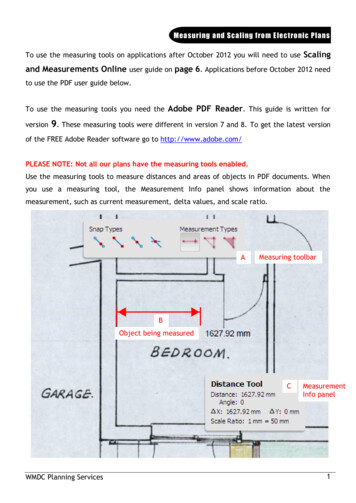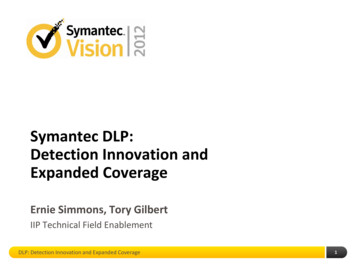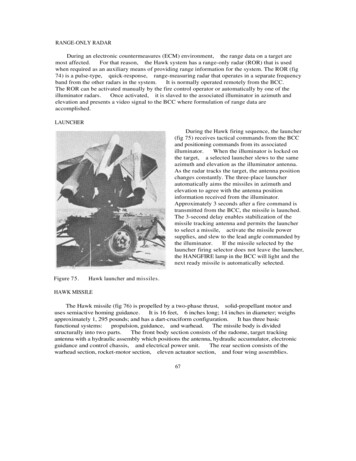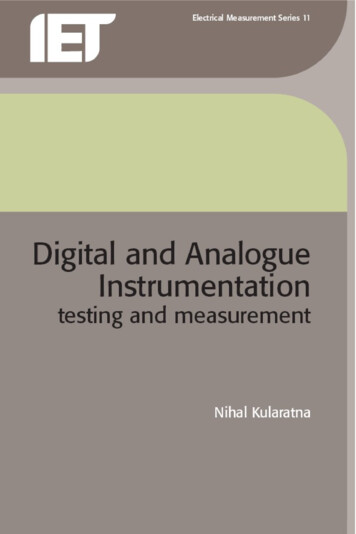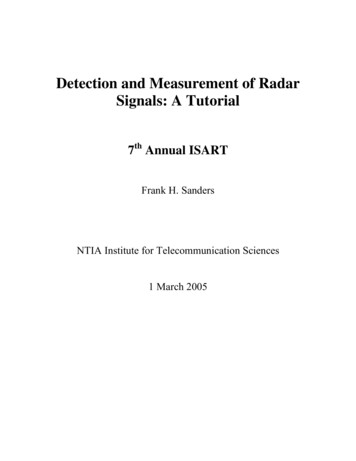
Transcription
Detection and Measurement of RadarSignals: A Tutorial7th Annual ISARTFrank H. SandersNTIA Institute for Telecommunication Sciences1 March 2005
OUTLINE1. RADAR EMISSION FUNDAMENTALSa) Pulse duty cyclesb)Transmitter peak power levelsc) Antenna gaind)US radar spectrum bands2. RADAR PARAMETERSa) Radar spectrum engineering criteria (RSEC)b)Waveform (pulse) width, rise time, fall time,modulationc) Pulse repetition rated)Antenna patternse) Emission spectraa. Measurement hardware and algorithmsb. Measurement dependence on bandwidthc. Do spectra have to be measured in the farfield?
RADAR EMISSION FUNDAMENTALS-Emissions are pulsed. Usually about 0.1% dutycycle (typically 1 us pulse width, and 1 ms pulserepetition interval).-Peak transmitter power levels often around 1 MW.-Antenna gain often around 30 dBi.-Peak EIRP levels around 1 GW.MissionShort rangeairsearchLong rangeair Peakpower(MW)An-tenna 3320.08-0.8100000.02300.021-530013000.7545242
MAJOR US RADAR SPECTRUM BANDS5-25 MHzHF OTH-B functions420-450 MHzspace search, airborne search902-928 MHzair search1215-1400 MHzlong range air search2700-2900 MHzair traffic control (terminals)2900-3100 MHzair & marine search, weather3100-3700 MHzair search5250-5925 MHzair search, weather8.5-10.5 GHzairborne functions13.4-14.0 GHzairborne functions15.7-17.7 GHzairborne functions24.05-24.25 GHzlow power (e.g., police radars)3
RADAR PARAMETERSRadar Spectrum Engineering Criteria (RSEC)- Established by NTIA, adhered to by all US FederalGovernment radars.- Is the basis for other radar emission standards,both internationally and domestically (for example,MIL-STD 494- Specifies, for radars, limits on spurious and out-ofband emissions (collectively called unwantedemissions).- Specifies additional requirements for radarperformance of factors such as antenna patterns,receiver selectivity, and receiver LO emissions.- Does NOT guarantee that no interference willoccur!!- Requires that many radar emission parametersneed to be measured so that emission masks can bedrawn.4
- Does not explain how to do the measurements—SeeNTIA Reports and ITU-R Recommendation M.1177for such explanations.5
RSEC Compliance Measurements Require:-Pulse width and rise time (or fall time)measurement;-Pulse repetition rate measurement (although thisrequirement may disappear soon)-Radar transmitter peak power measurement;-Radar antenna pattern measurement;-Radar emission spectrum measurement.6
WAVEFORM PARAMETER MEASUREMENTSFigure 1. Schematic diagram of RSEC pulse shape parameters. Note thatthe nominal flat top level may have to be estimated as a best-fit on thedetected envelope.7
Figure 2. Block diagram schematic for measuring waveform parametersusing a directional coupler.8
Figure 3. Block diagram schematic for measuring radiated waveform.9
Example Measurement DataFigure 4. Diagram of RSEC parameters for a weather radar pulse.10
Figure 5. Diagram of RSEC parameters for a short-range search radarpulse.11
Figure 6. Diagram of RSEC parameters for a phase-coded pulse withthree chips.12
Figure 7. Measurement of the frequency deviation in time of afrequency-modulated pulse.13
2. PULSE REPETITION RATEExample Measurement Data0.40Amplitude (detected volts)0.350.300.250.20pulse repetition interval 0.913 mSpulse repetition rate 1096 sec -10.1501234567Time (milliseconds)Figure 8. Example of a fixed-PRR radar pulse sequence.148910
Figure 9. Pulse repetition measurement on a single channel of afrequency-hopping radar made with a spectrum analyzer in a zero-Hertzspan mode and positive peak detection. The line is an estimatedthreshold for on-frequency pulses.15
Amplitude (detected volts)0.120.080.04000.51.01.52.0Time (msec)Figure 10. The pulse repetition rate of the same radar as that shown inFigure 9, but measured with a broadband detector configured as inFigure 3.16
5. EMISSION SPECTRATable 1. Determination of RSEC Measurement Bandwidth (Bm)Radar Modulation TypeNon-FM pulsed and phasecoded pulsedRSEC Measurement Bandwidth (Bm):Bm (1/t), where t emitted pulse duration (50% voltage) orphase-chip (sub-pulse) duration (50% voltage).Example for non-FM pulsed: If emitted pulse duration is 1 µs,then Bm 1 MHz.FM-pulsed (chirped)CWFM/CWPhase-coded CWMulti-mode radarsExample for phase-coded pulsed: If radar transmits 26-µsduration pulses, each pulse consisting of 13 phase-coded chipsthat are each 2µs in duration, then Bm 500 kHz.Bm (Bc/t)1/2, where Bc frequency sweep range during eachpulse and t emitted pulse duration (50% voltage).Example: If radar sweeps (chirps) across frequency range of1.3 MHz during each pulse, and if the pulse duration is 55 μs,then Bm 154 kHz.Bm 1 kHz; See sub-paragraph 4.2 of [1, Chapter 5] for RSECCriteria B, C and D.Example: Bm 1 kHz.Bm 1 kHz; See sub-paragraph 4.2 of [1, Chapter 5] for RSECCriteria B, C and D.Example: Bm 1 kHzBm (1/t), where t emitted phase-chip duration (50% voltage).Example for phase-coded pulsed: If chip duration is 2µs, thenBm 500 kHz.Calculations should be made for each waveform type asdescribed above, and the minimum resulting value of Bm shouldbe used for the emission spectrum measurement.Example: A multi-mode radar produces a mixture of pulsemodulations as used in the above examples for non-FM pulsedand FM-pulsed. These values are 1 MHz and 154 kHz,respectively. Then Bm 154 kHz.17
50Received Power in Indicated Bandwidth (dBm)403 MHz301 MHz300 kHz100 kHz30 kHz2010 kHz103 kHz01 kHz-10-20-30-40-50-60-700102030Arbitrary UnitsFigure 11. Example of a bandwidth progression measurement forassessment of the proper bandwidth in which to measure a radarspectrum for RSEC compliance.1840
Measured Power Level in Specified Bandwidth (dBm)100-10-20-30-40300 kHz100 kHz-50-60-70-80-9027002750280028502900Frequency (MHz)Figure 12. Emission spectrum measurement performed on a multi-modechirped radar.19
Figure 13. An example of a spectrum measurement error caused by anincorrect RF attenuation setting.20
Figure 14. Example spectrum of an air search radar.21
Figure 15. Example bandwidth progression measurement of thefundamental for the radar having the measured emission spectra ofFigure 16.22
Figure 16. Three spectra for a single radar for which the bandwidthprogression is shown in Figure 15.23
4. ANTENNA PATTERNS.Figure 17. Example radar antenna pattern for a surface search radar.24
Figure 18. Three antenna patterns (top) & median of patterns (bottom).25
APPENDIX A: DEFINITIONSA.1 Spectrum RegionsTable A-1. Definitions of Spectrum Regions and Related Terms, fromChapter 6 of [1]TermDefinitionNecessaryFor a given class of emission, the width of thebandwidthfrequency band which is just sufficient to ensure thetransmission of information at the rate and with thequality required under specified conditions. Necessarybandwidths for radars as a function of emission typeare provided in Annex J of [1].Out-of-bandEmission on a frequency or frequencies immediatelyemissionsoutside the necessary bandwidth which results fromthe modulation process, but excluding spuriousemission.SpuriousEmission on a frequency or frequencies which areemissionsoutside the necessary bandwidth and the level ofwhich may be reduced without affecting thecorresponding transmission of information. Spuriousemissions include harmonic emissions, parasiticemissions, intermodulation products and frequencyconversion products, but exclude out-of-bandemissions.UnwantedThese consist of spurious emissions and out-of-bandemissionsemissions.26
APPENDIX B: ENSURING ADEQUATE MEASUREMENTSYSTEM INPUT ATTENUATION FOR RSECMEASUREMENTSB.1 Hardline Coupling to a Radar TransmitterFor hardline-coupled measurements, some attenuation will likely be required between thedirectional coupler output and the measurement device input (see Figure 1). Referring to thisdiagram, the minimum decibel amount of attenuation, A, required will be:Aext P p L c Ain Pm(B-1)whereAext external attenuation (dB) as shown in Figure 1Pp peak power produced by the radar transmitter (dBm)Lc loss through the coupler (dB)Ain attenuation provided internally at the measurement device front end input (dB)Pm maximum input power to measurement instrument after input attenuator (dBm).For example, if the radar transmitter produces 1 MW ( 90 dBm) peak power, if the directionalcoupler output is 20 dB lower than that value, and if the maximum permissible signal allowed atthe spectrum analyzer input is 10 dBm with 50 dB of internal spectrum analyzer attenuationinvoked at the front end, then the amount of attenuation that needs to be inserted between thecoupler output and the spectrum analyzer input is(90–20–50–10) 10 dB.In this case, even with 50 dB of RF attenuation invoked in the instrument’s front end, anadditional 10 dB of external RF attenuation is required between the directional coupler and themeasurement device input.B.2 Radiated Coupling to a Radar TransmitterAll the caveats regarding maximum allowable input power levels and optimal linear responseand calibration range for measurement instrumentation, as described in section B.1 above, alsoapply to the case of radiative coupling between the measurement system and the radartransmitter. Here, the external attenuation, Aext, is inserted between the measurement antennaoutput connector and the measurement device (e.g., spectrum analyzer) input port. Thedifference is that the term for peak power at the measurement system antenna output connector,Pr, is (from Appendix C of [3]):27
Pr Pp Gt Gr 27.6 20 log( f ) 20 log(r )(B-2)wherePr peak power at the measurement system antenna output connector (dBm);Pp peak power produced by the radar transmitter (dBm);Gt radar transmitter antenna gain (dBi);Gr measurement system antenna gain (dBi);f measurement frequency (MHz);r distance between radar antenna and measurement antenna (meters).The variable Pr takes the place of Pp in Eq. B-1, and the value for the external attenuation, Aext,becomes:A ext Pr A in Pm(B-3)where all variables are as defined for Eq. B-1.For example, suppose a radar transmitter operates at 2800 MHz; that the transmitter produces1 MW peak power ( 90 dBm); that the transmitter antenna gain is 35 dBi; that themeasurement system antenna gain is 25 dBi; that the measurement system is positioned0.5 miles (0.8 km, or 800 m) from the radar; that the maximum allowable peak power to becoupled into the measurement system is 30 dBm; and that 50 dB of RF attenuation is to beinvoked within the measurement instrument RF front end. Then from Eq. B-2,Pr 90 35 25 27.6–20log(2800)–20log(800) 50.6 dBmAnd from Eq. B-3,Aext 50–50–30 –30 dB.The negative sign in the answer means that the signal coupled past the measurement instrumentRF front end will actually be 30 dB below the maximum allowable limit of 30 dBm for thissituation. No external attenuation is needed in this case.On the other hand, if the goal is to limit the peak power level that couples into the measurementinstrument beyond its own RF front end attenuation to a value of –20 dBm or less, thenAext 50–50–(–20) 20 dB.So in this case 20 dB of external attenuation would need to be inserted between the measurementantenna output connector and the input port of the measurement device.28
APPENDIX C: RSEC MEASUREMENT SYSTEMARCHITECTURE AND ALGORITHMSC.1 Hardware RequirementsFigure C-1. Block diagram of the RF front end and associated hardwarerequired for RSEC radar emission spectrum compliance measurements.29
Figure C-2. Block diagram of the RF front end and associated hardwarerequired for RSEC radar emission spectrum compliance measurementson high frequency (HF) radars operating below about 50 MHz.30
Figure C-4. RSEC measurement procedure flowchart.31
Table C-1. Measurement System Parameters for Determination of RadarFundamental Frequency or FrequenciesMeasurement systemparameterIF bandwidthVideo bandwidthDetection modeFrequency sweep rangeFrequency sweep rateTrace display modeFront end attenuationParameter setting1 MHzEqual to or greater than 1 MHzPositive peakOperational band of the radarMaximum allowed for the combinationof measurement bandwidth andfrequency sweep rangeMaximum holdSufficient to prevent measurementsystem overload (adjusted empirically)32
Figure C-4. Diagram of out-of-band and spurious emission suppressionlevels required by the RSEC. It should be noted that RecommendationITU-R SM.329 recommends under category B more stringent limits thanthose given within Appendix S3 in some cases. This should be taken intoaccount when evaluating the required range of measurement and therecommended dynamic range of the measurement system.33
APPENDIX D: MEASUREMENT SYSTEM CALIBRATIONFigure D-1. Lumped component diagram of noise diode calibration.Noise factor is the ratio of noise power from a device, ndevice(W), andthermal noise, ndevice where k is Boltzmann’s constant (1.38·10 23J/K), TkTBis system temperature in Kelvin, and B is bandwidth in hertz. The excessnoise ratio is equal to the noise factor minus one, making it the fractionof power in excess of kTB. The noise figure of a system is defined as 10log (noise factor). As many noise sources are specified in terms ofexcess noise ratio, that quantity may be used.34
In noise diode calibration, the primary concern is the difference in output signal when the noisediode is switched on and off. For the noise diode on condition, the power, Pon(W), is given by:p on (nf s enr d ) gkTB(D-1)where nfs is system noise factor and enrd is the noise diode enr.When the noise diode is off, the power, Poff(W), is given by:poff (nf s ) gkTB(D-2)The ratio between Pon and Poff is the Y factor: p (nf enr )sdy on nf s poff (D-3) p Y 10log(y) 10log on Pon Poff poff Hence the measurement system noise factor can be solved as:nf s enrdy 1(D-4)The measurement system noise figure is: enr NFs 10log d ENRd 10log(y 1) ENRd 10log(10Y /10 1) y 1 (D-5)pon poffenrd kTB(D-6)Hence:g G 10log(pon poff ) 10log(enrd kTB)or(G 10log 10 Pon /10 10Poff /10) ENRd 10log(kTB)In noise diode calibrations, the preceding equation is used to calculate measurement system gainfrom measured noise diode values.35
Although the equation for NFs may be used to calculate the measurement system noise figure,software may implement an equivalent equation:nf s (poff(D-7)gkTB)NFs 10 log poff 10 log( gkTB ) Poff G 10 log(kTB )And substituting the expression for gain into the preceding equation yields:(NFs Poff ENRd 10 log 10 Pon / 10 1036Poff / 10)(D-8)
APPENDIX E: POSITIONING OF MEASUREMENT SYSTEMFOR RADIATED MEASUREMENTSFigure E-1. Emission spectrum measurements of a maritime radar madeat distances of 105 m (D2/λ distance limit) and 65 m, well within thatdistance. Where the two spectra diverge, the far-field spectrum is lowerthan the near-field spectrum.37
APPENDIX F: VARIATION IN MEASURED PULSE SHAPESACROSS EXTENDED EMISSION SPECTRA(a)(b)(c)(d)Figure F-1. A weather radar pulse envelope measured at nominal radarcenter frequency (a), and at three other frequencies in the out-of-bandand spurious parts of the emission spectrum ((b) through (d)).Measurement bandwidth was 8 MHz. The emission lines convolved atthe center frequency in the measurement bandwidth yield a goodapproximation of the full-bandwidth pulse envelope in the time domain.But the subsets of Fourier lines convolved in the same bandwidth atfrequencies in the out-of-band spurious portions of the emissionspectrum do not yield the nominal pulse envelope; instead they tend toproduce high-amplitude features in the leading edge, trailing edge, orboth.38
APPENDIX G: VARIATION IN MEASURED SPURIOUSAMPLITUDES AS A FUNCTION OF MEASUREMENTBANDWIDTHFigure G-1. Maritime radar and measurement system.39
Figure G-2. Measurement system functional block diagram.40
Figure G-3. Maritime radar emission spectrum measured in fourbandwidths with transmitter operating in short-pulse mode.41
Figure G-4. Maritime radar emission spectrum measured in fourbandwidths with transmitter operating in long-pulse mode.42
Figure G-5. Variation in measured power at the radar fundamental as afunction of measurement bandwidth and pulse mode.43
44
45
Figure 1. Schematic diagram of RSEC pulse shape parameters. Note that the nominal flat top level may have to be estimated as a best-fit on the detected envelope. 8 Figure 2. Block diagram schematic for measuring waveform parameters using a directional coupler. 9 Figure 3.
